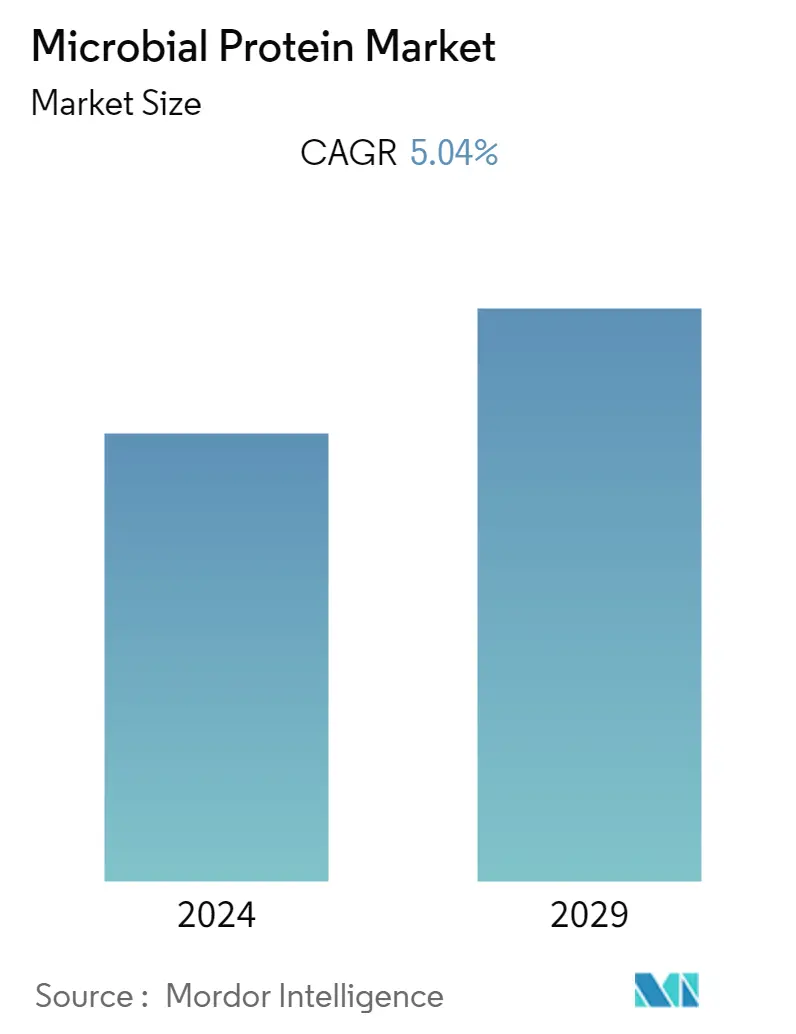Market Size of Microbial Protein Industry

| Study Period | 2019 - 2029 |
| Base Year For Estimation | 2023 |
| CAGR | 5.04 % |
| Fastest Growing Market | Asia Pacific |
| Largest Market | North America |
| Market Concentration | High |
Major Players
*Disclaimer: Major Players sorted in no particular order |
Need a report that reflects how COVID-19 has impacted this market and its growth?
Microbial Protein Market Analysis
The global microbial protein market is expected to grow from USD 24.2 million in 2023 at a CAGR of 5.04% over the next five years.
- The microbial protein market is an emerging and promising sector in the food and agriculture industry as these proteins have gained attention due to their potential to address various challenges faced by traditional protein sources like meat and plant-based proteins. With the increasing global demand for protein-rich foods and the environmental concerns associated with meat production, microbial proteins offer a viable alternative to traditional animal-based proteins.
- Microbial protein production is generally considered more sustainable compared to conventional animal agriculture. It requires fewer natural resources, emits fewer greenhouse gases, and has a smaller environmental footprint. Additionally, microbial proteins can be engineered to be nutritionally rich, providing essential amino acids and other nutrients, making them attractive for meeting dietary needs.
- Moreover, advances in biotechnology and fermentation technologies have made it even easier and more cost-effective to produce microbial proteins at scale. Several technologies are used in microbial protein production, which aims to optimize the yield, quality, and efficiency of producing proteins using microbial organisms.
- For instance, genetic engineering involves modifying the genetic material of microorganisms, such as bacteria, yeast, or fungi, to enhance their ability to produce specific proteins. This could include introducing genes that encode for the target protein or manipulating the organism's metabolic pathways to boost protein production.
- Such developments happening in the market, coupled with the market players' focus on innovations and developing new products with multiple application capabilities, are expected to further boost the market's growth during the forecast period.
Microbial Protein Industry Segmentation
Microbial protein refers to protein derived from microorganisms such as fungi, bacteria, or algae.
The global microbial protein market is segmented based on protein type, end-user, and geography. Based on the protein type, the market is segmented as algae protein and mycoprotein. Based on the end-user, the market is segmented as food and beverages, and supplements. By geography, the market is segmented into North America, Europe, and Asia-Pacific.
For each segment, the market sizing and forecasts have been done on the basis of value (in USD) and in volume terms (in tons) for all the above-mentioned segments.
| By Protein Type | |
| Algae Protein | |
| Mycoprotein |
| By End-User | ||||
| ||||
|
| By Geography | |||||||||||||
| |||||||||||||
| |||||||||||||
|
Microbial Protein Market Size Summary
The microbial protein market is an emerging sector within the food and agriculture industry, gaining traction due to its potential to address challenges posed by traditional protein sources like meat and plant-based proteins. As global demand for protein-rich foods rises and environmental concerns about meat production grow, microbial proteins present a sustainable alternative. These proteins require fewer natural resources, emit less greenhouse gas, and have a smaller environmental footprint compared to conventional animal agriculture. Advances in biotechnology and fermentation technologies have further enhanced the production of microbial proteins, making it more cost-effective and efficient. This has led to innovations in genetic engineering, where microorganisms such as bacteria, yeast, and fungi are modified to boost protein production, thereby meeting the increasing dietary needs and preferences for alternative protein sources.
The shift in consumer dietary preferences, particularly in regions like Europe and North America, is driving demand for alternative proteins, including microbial protein. As more consumers adopt flexitarian or vegan diets, the market for microbial protein is expanding, offering significant opportunities for manufacturers to innovate and introduce new products. This trend is supported by growing health, climate, and ethical concerns related to meat consumption, which have led to a decrease in meat consumption and increased interest in plant-based and alternative proteins. In the Asia-Pacific region, where there is a rising demand for protein-rich foods, microbial protein is seen as a potential solution to food security and sustainability challenges. Companies are actively developing microbial protein-based products, such as meat and dairy substitutes, to cater to this emerging market. The global microbial protein market is concentrated, with major players focusing on expansions, acquisitions, and partnerships to strengthen their market position and meet the growing demand for organic and sustainable food solutions.
Microbial Protein Market Size - Table of Contents
-
1. MARKET DYNAMICS
-
1.1 Market Drivers
-
1.1.1 Increasing demand for alternative protein sources
-
1.1.2 Multi-functional uses of microbial protein
-
-
1.2 Market Restraints
-
1.2.1 Growth and availability of other plant-protein sources
-
-
1.3 Industry Attractiveness - Porter's Five Forces Analysis
-
1.3.1 Threat of New Entrants
-
1.3.2 Bargaining Power of Buyers/Consumers
-
1.3.3 Bargaining Power of Suppliers
-
1.3.4 Threat of Substitute Products
-
1.3.5 Intensity of Competitive Rivalry
-
-
-
2. Market Segmentation
-
2.1 By Protein Type
-
2.1.1 Algae Protein
-
2.1.2 Mycoprotein
-
-
2.2 By End-User
-
2.2.1 Food and Beverages
-
2.2.1.1 Dairy and Dairy Alternative Products
-
2.2.1.2 Meat/Poultry/Seafood and Meat Alternative Products
-
-
2.2.2 Supplements
-
2.2.2.1 Elderly Nutrition and Medical Nutrition
-
2.2.2.2 Sport/Performance Nutrition
-
-
-
2.3 By Geography
-
2.3.1 Asia-Pacific
-
2.3.1.1 Australia
-
2.3.1.2 China
-
2.3.1.3 India
-
2.3.1.4 Indonesia
-
2.3.1.5 Japan
-
2.3.1.6 Malaysia
-
2.3.1.7 New Zealand
-
2.3.1.8 South Korea
-
2.3.1.9 Thailand
-
2.3.1.10 Vietnam
-
2.3.1.11 Rest of Asia-Pacific
-
-
2.3.2 Europe
-
2.3.2.1 France
-
2.3.2.2 Germany
-
2.3.2.3 Italy
-
2.3.2.4 United Kingdom
-
-
2.3.3 North America
-
2.3.3.1 Canada
-
2.3.3.2 Mexico
-
2.3.3.3 United States
-
2.3.3.4 Rest of North America
-
-
-
Microbial Protein Market Size FAQs
What is the current Global Microbial Protein Market size?
The Global Microbial Protein Market is projected to register a CAGR of 5.04% during the forecast period (2024-2029)
Who are the key players in Global Microbial Protein Market?
Algenol Biotech LLC, Corbion Biotech, Inc., ENOUGH (3F Bio Ltd.), Mycorena AB and Roquette Frère are the major companies operating in the Global Microbial Protein Market.

